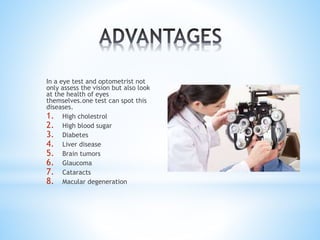The Role of Advanced Diagnostic Equipment in Identifying Eye Disorders
In the world of ophthalmology, the utilization of innovative analysis devices has actually transformed the early identification and management of numerous eye disorders. As the demand for precise and timely medical diagnoses continues to grow, the combination of cutting-edge tools like optical coherence tomography and visual area screening has become indispensable in the realm of eye care.
Significance of Early Diagnosis
Very early medical diagnosis plays an essential role in the effective management and therapy of eye conditions. By spotting eye conditions at a very early phase, medical care suppliers can offer appropriate therapy plans customized to the certain condition, eventually leading to much better outcomes for people.
Innovation for Spotting Glaucoma
Innovative diagnostic modern technologies play a critical duty in the early discovery and tracking of glaucoma, a leading cause of permanent loss of sight worldwide. One more innovative device is visual area screening, which maps the level of sensitivity of an individual's visual field, aiding to detect any locations of vision loss characteristic of glaucoma. These innovative analysis tools enable eye doctors to identify glaucoma in its early phases, allowing for prompt treatment and better monitoring of the condition to prevent vision loss.
Role of Optical Comprehensibility Tomography

OCT's ability to measure retinal nerve fiber layer thickness permits exact and objective measurements, assisting in the early detection of glaucoma also next page prior to visual area problems become evident. OCT modern technology allows longitudinal monitoring of structural adjustments over time, helping with customized treatment strategies and prompt treatments to help maintain people' vision. The non-invasive nature of OCT imaging likewise makes it a preferred choice for checking glaucoma development, as it can be duplicated frequently without causing discomfort to the patient. In general, OCT plays a crucial function in enhancing the analysis precision and administration of glaucoma, eventually adding to much better results for individuals in jeopardy of vision loss.
Enhancing Diagnosis With Visual Area Testing
A vital component in thorough ocular analyses, aesthetic field testing plays a pivotal duty in improving the analysis process for numerous eye disorders. By examining the complete level of a patient's aesthetic area, this examination offers vital info about the practical stability of the entire visual pathway, from the retina to the aesthetic cortex.
Aesthetic area testing is specifically beneficial in the medical diagnosis and management of conditions such as glaucoma, optic nerve problems, and different neurological conditions that can influence vision. Via measurable dimensions of outer and main vision, here are the findings clinicians can discover subtle changes click for more info that might suggest the existence or progression of these conditions, also prior to visible signs happen.
Furthermore, aesthetic area screening permits the surveillance of therapy efficacy, assisting eye doctors tailor restorative interventions to private clients. eyecare near me. By tracking modifications in visual area performance in time, doctor can make enlightened choices regarding changing medicines, recommending surgical treatments, or carrying out other ideal procedures to protect or improve a patient's aesthetic feature
Managing Macular Deterioration

Final Thought
In final thought, progressed analysis tools play an essential function in determining eye disorders at an early stage. Technologies such as Optical Comprehensibility Tomography and visual area testing have greatly improved the precision and performance of diagnosing conditions like glaucoma and macular deterioration. Early detection allows for timely intervention and monitoring of these conditions, inevitably leading to much better outcomes for people. It is necessary for medical care specialists to remain upgraded on these innovations to provide the most effective possible take care of their people. eyecare near me.
Comments on “Finest Refractive Surgeries in AL: State-of-the-Art Eye Treatment”